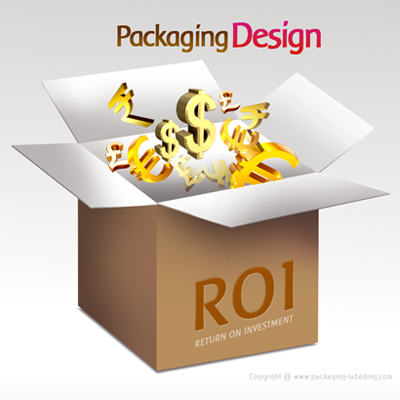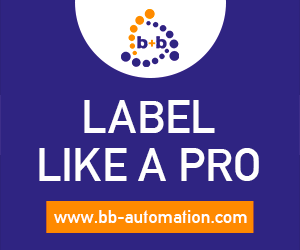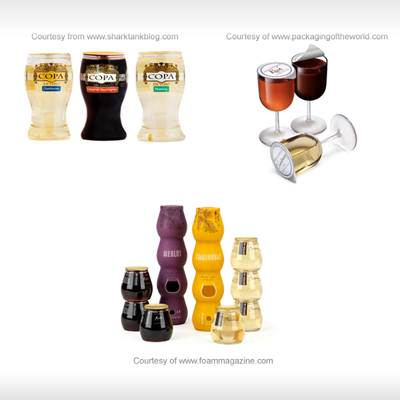Articles
Packaging Design and Return-on-Investment (ROI)

Every company is in the business of selling something, whether it be a product or a service. Every product or service is packaged. Every package design should represent an extension of the brand assets of that company. If the brand identity and package design is in line with the brand strategies and marketing initiatives, the end result is packaging that contributes to marketing ROI in a substantial way.
Realizing how different investments will profit the company is an evident assistance in planning and allocating budgets effectively. An empirical ROI measure may also help to convince financiers to take a risk and release money for a design and development project. Even if it is hard to achieve, attempting to gain some measure of ROI in design is of value to both consultancy and client because it creates a mutually supporting commercial framework.
Many marketers are beginning to believe that packaging is as complicated as to building brand equity and achieving ROI is difficult as advertising is. Nevertheless corporate package design budgets are very small compared with advertising budgets.
Packaging an essential tool which expresses a brand's asset yields a far greater ROI than a normal advertising. As explained by researchers from various brand consultancies, corporate statistics and independent research, that package design, an integral part of a brand identity system, can exceed up to three advertising campaigns and more than eight promotional cycles.
Definitely, there’s no single explanation as to why some initiatives taken by companies succeed and others don’t meet expectations. However, across numerous brands, categories, and countries, researches have distinguished five common mistakes/decisions that determine failure, including:
- Redesigns: Big companies have consistent research systems in place for assessing or “validating” new packaging systems prior to launch. Just for the desire to “create some news” many packaging comapnies attempt redesign. As a result, considerable resources are spent on innovation or redesign efforts that aren’t necessary.
- Problem Solving: Many efforts are rooted in misguided assumptions about the brand and its packaging (e.g., “the packaging looks old”; “it needs to be easier to hold”; etc.). Thus, a great deal of time and energy is channeled in one direction, only to eventually uncover a very different issue by way of on-shelf and/or in-home testing. For example, “improving shelf visibility” is a standard objective on nearly all design briefs. And while visibility is absolutely critical for smaller brands and new product introductions, shoppability and sub-brand differentiation are often more pressing issues for large master brands, such as Colgate, Dove, and Tide.
- Core design equities: In today’s world of overwhelming clutter and choice, purchase decisions are driven primarily by what people see and by how they feel about the products they usually buy. Thus, visual equities-including unique, ownable shapes, colors, and icons are more important than ever to help shoppers navigate expanding aisles and identify familiar brands. Frequent changes in the product designs, in terms of colors, shapes, icons creates confusion amongst the buyers for the products. They start feeling taht their product doesn’t exist anymore.
Naturally, brands can’t stay the same for a lifetime, but the key to successful restages is properly balancing disruption and continuity: If there’s a sudden change to one core visual equity such as a new package shape or a primary visual, it’s necessary to retain other core elements, such as package color or brand identity etc. In addition, marketers should ensure that front-of-pack messaging helps explain sudden changes in packaging appearance (e.g., “New Look,” or “Improved Formula”).
Measuring ROI in design is not easy and in many cases is an imperfect science. While we focused largely on what not to do, the encouraging news is that companies can systematically increase their likelihood of success with package design.
What is ‘return’ in packaging?
A return might be a hard, definable measure such as sales, footfall or market share; but equally, it might be a ‘softer’ measure such as brand awareness, public perception or even staff morale, it may also be a combination of both types of impact. The soft measures are hard to quantify but are still measurable using different research methods. A few possible ‘returns’ that a client may look for:
- Rebranding shift, perhaps to change perceptions or to compete with a rival product or service
- Increased visitors or footfall
- Longer dwell time
- Clearer information on forms and leaflets and therefore fewer calls to customer helplines
- Use of more sustainable materials
- Innovation or conceptual research leading to possible new products
- Increased product sales or market share
What is ‘investment’ in packaging?
Similarly, investment can be defined as the fees or charge, inturn paying a design company’s fees which is just a part of the cost of a design project.
The investments made by companies generally include:
- Cost of materials/goods
- Possible changes to manufacturing processes
- Tooling costs
- Engineering costs
- Distributions costs
- Staff time spent on a project
- Write-offs of old materials/products
- Other sales, marketing and promotional activity
When a design process is in motion, designers very often make intuitive decisions about colour, form, texture, functionality and so on. One way to assess these creative intuitions commercially is to set up control measures, where old and new designs are allowed to perform ‘side by side’.
Across nearly all organizations, research is weighted heavily toward back-end validation to inform final decisions. when investments have already been made and often when teams are up against deadlines and/or are committed to making changes. To improve the process, companies need more information and insights at the outset of design initiatives, to identify opportunities, allocate resources appropriately, and provide direction. Specifically, companies need to understand the strengths, limitations, and equities of their current packaging, Its just as doing a SWOT analysis of the products.
By evaluating current packaging relative to competition on-shelf, in-hand, and in-use and by identifying design equities via various drawing and recognition exercises, we are able to inform design briefs and set clear objectives and action standards. Ultimately, this helps ensure that each redesign effort is solving the actual problem and addressing an actual shopper need or competitive disadvantage without wastage time.
Another best practice is to integrate the shopping context and store environment into the design brief, by analysing the shopper’s way-to-purchase, the retail realties of key channels, and the role of packaging in the complete shopping experience.
More and more, this process includes realizing the era of digital world, which includes the interaction between online and person to person shopping, and the role of smartphones and QR codes in the narrow passage. Collectively, this shopper insight helps define the core mission of the packaging and it also helps to determine how to properly adapt packaging to for different products as per retail outlets and shoppers interests.
Companies are facing new realities in the marketplace, with the emergence of more market customization which has created new demands and new challenges for corporate marketing departments and consultancies alike. Many of today's new market segments have limited the overall success of mass marketing, and eroded brand loyalty. Add to this scenario, there are a plethora of private label offerings at retail stores, which have started to affect the "premium value" image of branded products, and slow the sales of "national brands." Customer expectations are rising day by day with various brands popping up. Big Brands are now in a fix on how to make the best designs and market them to have the best ROI on it.
Corporate marketers are not alone in dealing with these complications and many others in an increasingly competitive, global marketplace. All of their corporate counterparts must incorporate flexibility into their business plans, and again, seek to align corporate goals and marketing goals.
Companies design and manufacture products but customers buy the products which they like. Customers prefer, the design the over all brand name. The most successful brands are carefully managed and consistent. Well-informed marketers know that retaining customers while acquiring new ones is the best way to maximize ROI and beat the competition. Delivering on the brand message with sound marketing strategies, leading the brand values in the packaging of the corporation's products and services, drive relevant customer experiences and ultimately build brand loyalty with best ROI’s on it.









